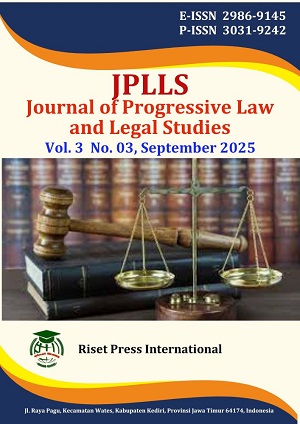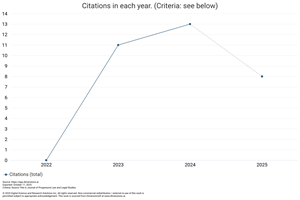Application of Immanuel Kant's Retributive Theory in Death Penalty Sentencing for Premeditated Murder Following Constitutional Court Decision No. 21/PUU-VI/2008
DOI:
https://doi.org/10.59653/jplls.v3i03.2005Keywords:
Retributive justice, Immanuel Kant, death penalty, premeditated murder, Constitutional Court Decision, proportionality, human rightsAbstract
This study examines the application of Immanuel Kant's retributive justice theory in judicial decisions imposing death sentences for premeditated murder cases in Indonesia, particularly following the landmark Constitutional Court Decision No. 21/PUU-VI/2008. The research employs a normative juridical approach, analyzing secondary legal materials including legislation, court decisions, legal doctrines, and philosophical theories. Kant's retributive theory posits that punishment must be proportionate to the moral culpability of the offender, embodying the principle of ius talionis. However, the Constitutional Court's decision has reframed the death penalty as an exceptional and alternative sanction, requiring judges to consider principles of proportionality and individualization. This study reveals a fundamental tension between classical Kantian retributivism, which demands absolute proportionality regardless of consequentialist considerations, and the Constitutional Court's approach that increasingly emphasizes human rights protection and gradual abolitionism. The findings demonstrate that while judges rhetorically invoke retributive principles in their reasoning, practical application has become constrained by constitutional imperatives that prioritize rehabilitation and the right to life. This normative contradiction suggests an evolutionary shift in Indonesia's criminal justice philosophy from pure retribution toward a more nuanced balancing of retributive, rehabilitative, and human rights considerations.
Downloads
References
Ariawan, D. (2025). Discourse on Conditional Death Penalty through Probationary Period of Imprisonment Under the New Criminal Code in Perspective of Restorative Justice. In Ius Poenale (Vol. 5, Issue 2, pp. 91–100). Fiat Justisia. https://doi.org/10.25041/ip.v5i2.3587
Asa’ari, A., Ahmad, J., Zufriani, Z., Witro, D., & Kustiawan, M. T. (2023). Considering Death Penalty for Corruptors in Law on Corruption Eradication from the Perspective of Maqāsid al-Syarī‘ah. Samarah, 7(2). https://doi.org/10.22373/sjhk.v7i2.14944
Bessler, J. (2022). The Death Penalty’s Denial of Fundamental Human Rights. In The Death Penalty’s Denial of Fundamental Human Rights. https://doi.org/10.1017/9781108980159
Christiansen, N., & Bakhtiar, H. S. (2025). The Application of Trial as an Adult Concept in Indonesia: Justice for Victims in Juvenile Murder Cases. In Journal of Law, Politic and Humanities (Vol. 5, Issue 5, pp. 3496–3504). Yayasan Dharma Indonesia Tercinta (Dinasti). https://doi.org/10.38035/jlph.v5i5.1950
De Ungria, M. C. A., & Jose, J. M. (2020). The war on drugs, forensic science and the death penalty in the Philippines. Forensic Science International: Synergy, 2. https://doi.org/10.1016/j.fsisyn.2019.11.002
Jouet, M. (2023). Death Penalty Abolitionism from the Enlightenment to Modernity. American Journal of Comparative Law, 71(1). https://doi.org/10.1093/ajcl/avad011
Klempe, S. H. (2025). Empirical Psychology Removed from Metaphysics: Immanuel Kant. In Theory and History in the Human and Social Sciences (pp. 51–77). Springer Nature Switzerland. https://doi.org/10.1007/978-3-031-89595-1_4
Libraty, C., Ramadhan, M. F., & Jannah, M. (2025). DEATH PENALTY IN THE PERSPECTIVE OF ISLAMIC LAW AND LAW NO. 39 OF 1999 CONCERNING HUMAN RIGHTS MAN. In ISLAMIC LAW AND LOCAL WISDOM (Vol. 1, Issue 1). Universitas Muslim Indonesia. https://doi.org/10.56087/islam.v1i1.4
Mahajan, D. (2025). Comparative Analysis of Death Penalty Practices Socio-Political Influences in India and Indonesia. In SSRN Electronic Journal. Elsevier BV. https://doi.org/10.2139/ssrn.5150309
McCarthy, D., & Brunton-Smith, I. (2024). Attitudes towards the death penalty: An assessment of individual and country-level differences. European Journal of Criminology, 21(1). https://doi.org/10.1177/14773708221097670
Montaña, R. (2025). Justice and Human Rights: A Gewirthian-Thomistic Perspective. In Scientia - The International Journal on the Liberal Arts (Vol. 14, Issue 1, pp. 1–13). San Beda University. https://doi.org/10.57106/scientia.v14i1.193
Oliphant, S. N. (2022). Estimating the effect of death penalty moratoriums on homicide rates using the synthetic control method. Criminology and Public Policy, 21(4). https://doi.org/10.1111/1745-9133.12601
Pascoe, D., & Miao, M. (2017). Victim-perpetrator reconciliation agreements:what can muslim-majority jurisdictions and the PRC learn from each other? In International and Comparative Law Quarterly (Vol. 66, Issue 4). https://doi.org/10.1017/S0020589317000409
Purba, T. P. P. R., Amalia, P., & Trisnamansyah, P. (2025). Reformulating the Definition of International Arbitral Awards in Indonesia: Responding to Constitutional Court Decision No. 100/2024 and a Comparative Analysis with the Regulation of International Arbitration in Other Countries. In Journal of Law, Politic and Humanities (Vol. 5, Issue 6, pp. 4761–4773). Yayasan Dharma Indonesia Tercinta (Dinasti). https://doi.org/10.38035/jlph.v5i6.2220
Putra, Y. P., & Sadjijono, Prof. Dr. S. (2025). LEGAL PROTECTION FOR VICTIMS OF MURDER COMMITTED BY CHILDREN: A PERSPECTIVE OF THE INDONESIAN CHILD PROTECTION LAW. In Journal of Court and Justice (pp. 51–69). JF Publisher. https://doi.org/10.56943/jcj.v4i4.846
Rana, S., Mia, T., & Billah, M. (2025). JUSTICE, HUMAN RIGHTS, AND LEGAL REFORM. In Isagoge - Journal of Humanities and Social Sciences (Vol. 5, Issue 1, pp. 302–330). Telos Publicações e Serviços Ltda. https://doi.org/10.59079/isagoge.v5i1.267
Salsabila, & H, M. R. M. (2025). Abortion Law as Premeditated Murder: Assessing the Equality of Human and Fetal Rights to Life. In Jurnal Cakrawala Akademika (Vol. 1, Issue 6). PT. Teman Tugasmu Publisher. https://doi.org/10.70182/jca.v1i6.329
Setiodjati, J., & Hamidi, A. (2025). Cancellation of Death Penalty For Narcotics Producer In Human Rights Perspective. In Indonesian Journal of Law and Justice (Vol. 2, Issue 3, p. 8). Indonesian Journal Publisher. https://doi.org/10.47134/ijlj.v2i3.3865
Shaffer, R. (2025). Imperial Gallows: Murder, Violence and the Death Penalty in British Colonial Africa, c.1915–60. In The Journal of Imperial and Commonwealth History (Vol. 53, Issue 1, pp. 202–204). Informa UK Limited. https://doi.org/10.1080/03086534.2025.2455624
Sibuea, J. H., & Prasetyo, B. (2025). IMPOSITION OF PUNISHMENT AGAINST DOENPLEGER OF ATTEMPTED PREMEDITATED MURDER VIEWED THROUGH THE ASPECT OF JUSTICE. In Syiah Kuala Law Journal (Vol. 9, Issue 1). LPPM Universitas Syiah Kuala. https://doi.org/10.24815/sklj.v9i1.45153
Sodikin, S., & Suhaedi, E. S. E. (2025). Order to Commit Premeditated Murder: Based on District Court Decision Number 1880/Pid.B/2021/PN.Tng. In International Journal of Advances in Engineering and Management (Vol. 7, Issue 7, pp. 79–86). Quest Journals. https://doi.org/10.35629/5252-07077986
Sujono, I. (2022). URGENCY OF RECHTSVINDING AND JURISPRUDENCE IN THE CONSTITUTIONAL COURT AUTHORITY: URGENSI PENEMUAN HUKUM DAN YURISPRUDENSI DALAM KEWENANGAN MAHKAMAH KONSTITUSI. Constitutional Law Society, 1(2), 161–178.
Sujono, I., Baehaqi, J., Manullang, S. O., Rusli, M., & Dewi, R. S. (2024). Exploratory of cybercrime in law perspective, a research using bibliometric approach. AIP Conference Proceedings, 2927(1), 60044. https://doi.org/10.1063/5.0192525
Tawaqal, M. F., & Ramada, D. P. (2025). DETERMINATION OF JUSTICE COLLABORATOR IN THE INDONESIAN CRIMINAL JUSTICE SYSTEM: ANALYSIS OF SNG DISTRICT COURT DECISION NUMBER 79/PID.B/2024. In EKSEKUSI (Vol. 7, Issue 1, p. 119). Universitas Islam Negeri Sultan Syarif Kasim Riau. https://doi.org/10.24014/je.v7i1.37304
Widyatama, A., & Sujono. (2025). LAW ENFORCEMENT OF THEFT WITH VIOLENCE RESULTING IN DEATH BASED ON THE PERSPECTIVE OF JUSTICE. In JILPR Journal Indonesia Law and Policy Review (Vol. 7, Issue 1, pp. 38–48). International Peneliti Ekonomi, Sosial, dan Teknologi. https://doi.org/10.56371/jirpl.v7i1.504
Downloads
Published
How to Cite
Issue
Section
License
Copyright (c) 2025 Imam Sujono

This work is licensed under a Creative Commons Attribution-ShareAlike 4.0 International License.
Authors who publish with this journal agree to the following terms:
- Authors retain copyright and grant the journal right of first publication with the work simultaneously licensed under a Creative Commons Attribution-ShareAlike that allows others to share the work with an acknowledgement of the work's authorship and initial publication in this journal.
- Authors are able to enter into separate, additional contractual arrangements for the non-exclusive distribution of the journal's published version of the work (e.g., post it to an institutional repository or publish it in a book), with an acknowledgement of its initial publication in this journal.
- Authors are permitted and encouraged to post their work online (e.g., in institutional repositories or on their website) prior to and during the submission process, as it can lead to productive exchanges, as well as earlier and greater citation of published work (See The Effect of Open Access).
























